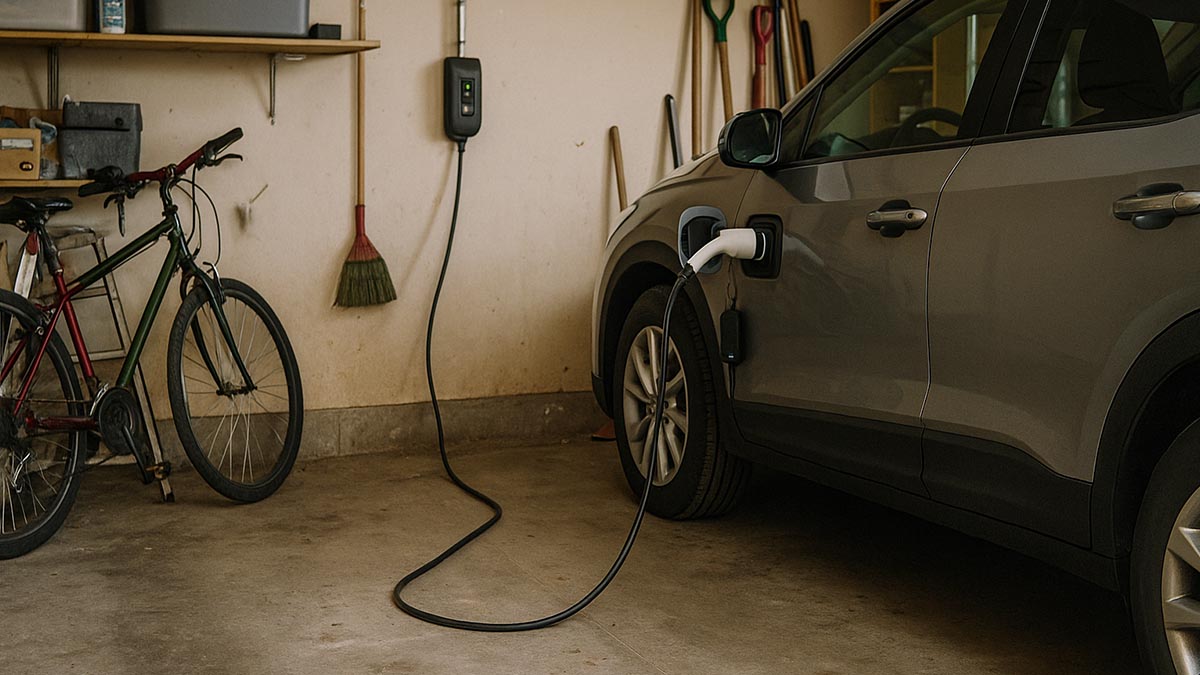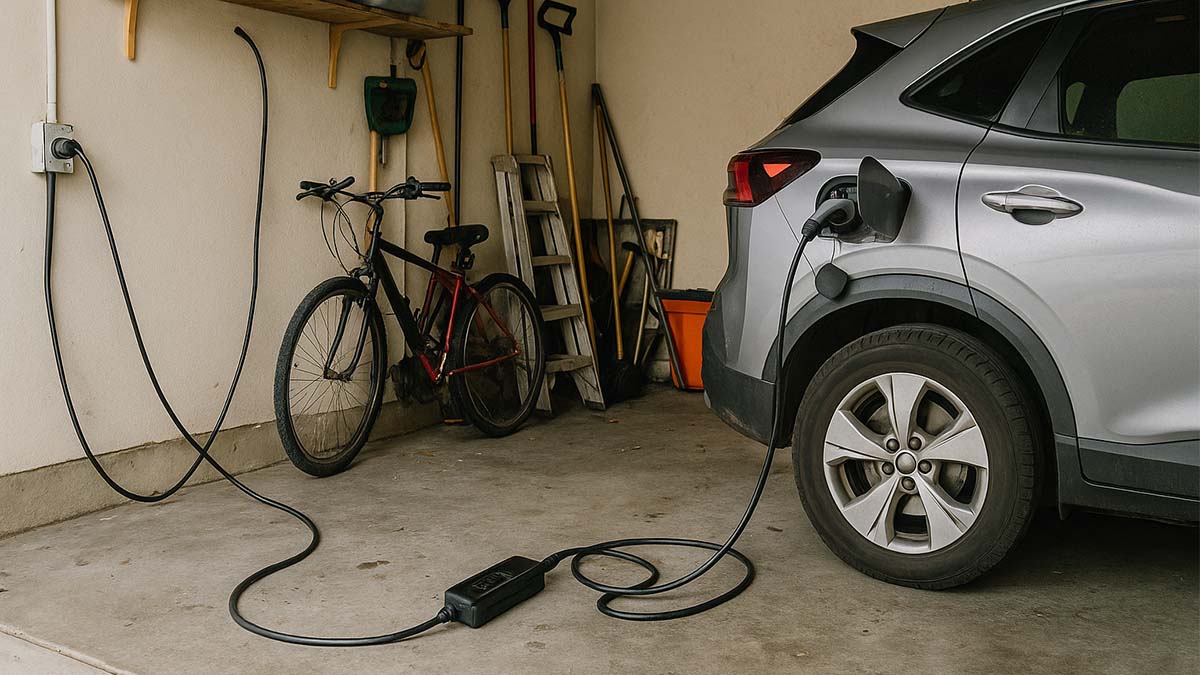
New EV drivers and fleet managers often ask the same set of questions about portable charging. This guide answers them in plain language, so readers can make safe choices at home, on the road, or at work.

What Counts as a Portable EV Charger?
Portable charging falls into three practical categories.
• Level 1 or Mode 2 cords
In North America this is a 120 V cord with a control box. In Europe and many other regions it is a 230 V Mode 2 cable. Both plug into standard outlets and work everywhere, but they refill slowly.
• Level 2 portable EVSE
A compact control box with a vehicle connector and changeable wall plugs. On single phase it typically provides 3.6–7.4 kW. In three-phase markets it can reach 11–22 kW with the correct plug.
• Mobile DC units
Battery trailers or vans that deliver DC fast charging on site. These are great for events, roadside assistance, or fleet yards, but they are not a consumer product due to size and cost.
Is a Portable EV Charger Safe?
Yes, when the device is certified and used correctly. Check the following before you plug in.
• Certifications that match your market, such as UL or ETL in North America and CE or UKCA in Europe
• Built-in protection: ground-fault, overcurrent, overtemperature, surge protection
• Outdoor ratings that suit your climate, for example IP65 on the control box and splash protection on the handle
• Heavy-duty cable with molded strain relief and a plug that fits firmly in the outlet
• A dedicated circuit where possible. If a plug becomes hot or smells scorched, stop and ask an electrician to inspect the outlet
How to Charge in an Emergency?
Use the simplest safe option first.
Navigate to the nearest public charger. Even slow AC posts add enough energy to continue your trip.
Use the portable cord on a safe household outlet while you arrange a better option.
Call roadside assistance. Many providers now offer mobile charging or towing to DC fast charging.
As a last resort, a generator or power station can add a small amount of range. Treat this as a recovery tool, not everyday charging.
Typical Power and Range Added
|
Charging option |
Approx. power |
Range gained per hour* |
|
Level 1, 120 V 12 A |
1.4 kW |
3–5 mi / 5–8 km |
|
Mode 2, 230 V 10–16 A |
2.3–3.7 kW |
10–20 mi / 15–30 km |
|
Level 2, single-phase |
7.0 kW |
20–30 mi / 30–50 km |
|
Level 2, three-phase |
11–22 kW |
35–70+ mi / 55–110+ km |
|
DC fast |
50–150 kW |
150–500+ mi / 240–800+ km |
*Estimates vary by vehicle, state of charge, temperature, and elevation.
Is There a Mobile EV Charging Unit?
Yes. Two types are common.
• Battery-powered vans or trailers with onboard inverters that provide DC charging where cars are parked
• Generator-equipped service trucks that supply power at events or during roadside incidents.
They are useful for operations teams and service providers rather than private owners.
How to Charge a Car Without Installing a Wallbox
Charging must route through an EVSE, which manages the handshake and safety with the vehicle. Good options that avoid permanent installation:
• Keep the factory portable cord in the trunk
• Carry a Level 2 portable EVSE and the right adapters for local sockets, such as NEMA 14-50 in North America or CEE plugs in Europe
• Use public charging whenever it is nearby
Skip DIY or unverified adapters, and never defeat the EVSE’s protection and control logic.

Is There a Self-Charging Electric Vehicle?
No. Regenerative braking recovers some energy while driving and small solar panels can top up slowly, but they do not replace grid charging.
Can You Buy Your Own EV Charger?
Yes. Homeowners and businesses do this every day. When choosing a device, match it to your vehicles and power supply.
• Connector standard: J1772 Type 1, Type 2, NACS, or regional standard
• Power level: 32–40 A single-phase covers most homes; three-phase 11–22 kW suits European driveways and commercial sites
• Smart functions: load balancing, scheduling, RFID, and open protocols for fleet or building integration
• Cable details: length, jacket flexibility in cold weather, strain relief durability
• Outdoor rating and operating temperature range that match real conditions
• Professional installation for hardwired units
Can a Power Station Such as Jackery Charge an EV?
Technically yes, but only for short top-ups. Most portable power stations store 1–5 kWh and output 1–3 kW. That is enough to add a few miles to reach a safer location. Confirm the inverter is pure sine and rated for continuous load.
What Is a Level 1 EV Charger?
In North America it refers to 120 V charging through a portable cord set. It adds a little range per hour and works best for low daily mileage or overnight refills. In many other regions a 230 V Mode 2 cable plays a similar role and is somewhat faster than 120 V.
Safety Checklist You Can Publish
• Use certified equipment appropriate for the local grid
• Keep connectors out of puddles and cap them when not in use
• Don’t string adapters together or chain multiple extension cords in series
• If a breaker trips, stop and investigate the cause rather than immediately resetting
• Keep the portable EVSE in a moisture-proof pouch and routinely check the cable jacket and O-ring seals
Buying Advice by Scenario
• Apartment living or frequent travel
Choose a Level 2 portable EVSE with interchangeable plugs. It gives flexibility across different outlets and can live in the trunk.
• Homeowner with off-street parking
A 32–40 A wallbox provides faster daily charging and smart scheduling. Keep a portable unit as a backup for trips.
• Fleet and site operators
Three-phase 11–22 kW AC is ideal for shift or overnight parking. Add DC where turnaround time matters. Consider cable management, holsters, and weather protection to keep connectors clean.
• Harsh climates
Choose equipment with strong ingress protection, glove-friendly handles, cold-flexible cable jackets, and tight-sealing dust caps.
What to Keep in the Trunk
• Portable EVSE and its protective caps
• The correct adapters for regional sockets and one heavy-duty extension rated for the load if you must use it
• Microfiber cloth and a small brush for pins, caps, and O-rings
• Reflective triangle and gloves for roadside stops
Explore Workersbee solutions:
• Portable Type 2 smart charger (single-phase and three-phase options)
• J1772 portable Level 2 charger designed for both home use and travel.
• 22 kW three-phase portable EV charger (interchangeable CEE plugs)
• CCS2 EV charging cable, 375 A naturally cooled
• Liquid-cooled DC charging cable for high-power sites
• NACS connector and cable solutions
• Charging accessories: inlets, outlets, and adapters
Need help choosing? Share your outlet type (for example NEMA 14-50, CEE 16 A/32 A), cable length, and climate, and we’ll map the safest portable charger and accessories for your use case.